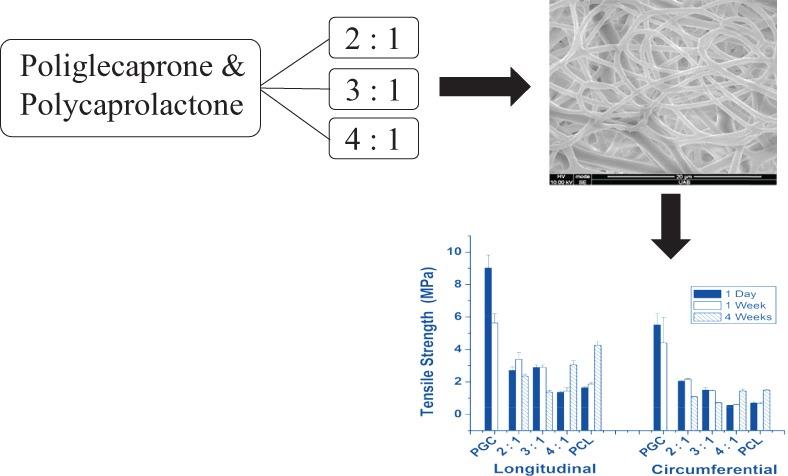Fibro-porous poliglecaprone/polycaprolactone conduits: synergistic effect of composition and in vitro degradation on mechanical properties
Harsh N Patel, Roman Garcia, Carrie Schindler, Derrick Dean, Steven M Pogwizd, Raj Singh, Yogesh K Vohra, Vinoy Thomas
下载PDF
{"title":"Fibro-porous poliglecaprone/polycaprolactone conduits: synergistic effect of composition and in vitro degradation on mechanical properties","authors":"Harsh N Patel, Roman Garcia, Carrie Schindler, Derrick Dean, Steven M Pogwizd, Raj Singh, Yogesh K Vohra, Vinoy Thomas","doi":"10.1002/pi.4834","DOIUrl":null,"url":null,"abstract":"<p>Blends of poliglecaprone (PGC) and polycaprolactone (PCL) of varying compositions were electrospun into tubular conduits and their mechanical, morphological, thermal and <i>in vitro</i> degradation properties were evaluated under simulated physiological conditions. Generally, mechanical strength, modulus and hydrophilic nature were enhanced by the addition of PGC to PCL. An <i>in vitro</i> degradation study in phosphate-buffered saline (pH 7.3) was carried out for up to 1 month to understand the hydrolytic degradation effect on the mechanical properties in both the longitudinal and circumferential directions. Pure PCL and 4:1 PCL/PGC blend scaffolds exhibited considerable elastic stiffening after a 1 month <i>in vitro</i> degradation. Fourier transform infrared spectroscopic and DSC techniques were used to understand the degradation behavior and the changes in structure and crystallinity of the polymeric blends. A 3:1 PCL/PGC blend was concluded to be a judicious blend composition for tubular grafts based on overall results on the mechanical properties and performance after a 1 month <i>in vitro</i> degradation study. © 2014 Society of Chemical Industry</p>","PeriodicalId":20404,"journal":{"name":"Polymer International","volume":"64 4","pages":"547-555"},"PeriodicalIF":2.9000,"publicationDate":"2014-11-05","publicationTypes":"Journal Article","fieldsOfStudy":null,"isOpenAccess":false,"openAccessPdf":"https://sci-hub-pdf.com/10.1002/pi.4834","citationCount":"16","resultStr":null,"platform":"Semanticscholar","paperid":null,"PeriodicalName":"Polymer International","FirstCategoryId":"92","ListUrlMain":"https://onlinelibrary.wiley.com/doi/10.1002/pi.4834","RegionNum":4,"RegionCategory":"化学","ArticlePicture":[],"TitleCN":null,"AbstractTextCN":null,"PMCID":null,"EPubDate":"","PubModel":"","JCR":"Q2","JCRName":"POLYMER SCIENCE","Score":null,"Total":0}
引用次数: 16
引用
批量引用
Abstract
Blends of poliglecaprone (PGC) and polycaprolactone (PCL) of varying compositions were electrospun into tubular conduits and their mechanical, morphological, thermal and in vitro degradation properties were evaluated under simulated physiological conditions. Generally, mechanical strength, modulus and hydrophilic nature were enhanced by the addition of PGC to PCL. An in vitro degradation study in phosphate-buffered saline (pH 7.3) was carried out for up to 1 month to understand the hydrolytic degradation effect on the mechanical properties in both the longitudinal and circumferential directions. Pure PCL and 4:1 PCL/PGC blend scaffolds exhibited considerable elastic stiffening after a 1 month in vitro degradation. Fourier transform infrared spectroscopic and DSC techniques were used to understand the degradation behavior and the changes in structure and crystallinity of the polymeric blends. A 3:1 PCL/PGC blend was concluded to be a judicious blend composition for tubular grafts based on overall results on the mechanical properties and performance after a 1 month in vitro degradation study. © 2014 Society of Chemical Industry
纤维-多孔聚己内酯/聚聚甲氨酮管道:组成和体外降解对机械性能的协同效应
将不同组成的聚己内酯(PCL)和聚己卡戊酮(PGC)电纺成管状管道,在模拟生理条件下对其力学、形态、热性能和体外降解性能进行了评价。一般来说,PGC加入PCL后,其机械强度、模量和亲水性都得到了提高。在pH 7.3的磷酸盐缓冲盐水中进行了长达1个月的体外降解研究,以了解水解降解对纵向和周向力学性能的影响。纯PCL和4:1 PCL/PGC共混支架在体外降解1个月后表现出相当大的弹性硬化。利用傅里叶变换红外光谱和DSC技术研究了聚合物共混物的降解行为以及结构和结晶度的变化。经过1个月的体外降解研究,从力学性能和性能的总体结果来看,3:1的PCL/PGC共混物是一种合适的管状移植物共混物组合。©2014化学工业学会
本文章由计算机程序翻译,如有差异,请以英文原文为准。



